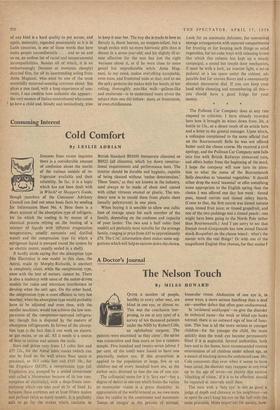Consuming Interest
Cold Comfort
By LESLIE ADRIAN JUDGING from recent inquiries there is a considerable amount of confusion about the merits of the various models of re- frigerator available and their reliability. So far, it is a topic which has not been dealt with in Which? or Shopper's Guide, though members of the Consumer Advisory Council can find out some basic facts by sending for Information Sheet No. 4. Here there is a short account of the absorption type of refrigera- tor (in which the cooling is by means of a chemical process relying on the heating of a mixture of liquids with different evaporation temperatures, usually ammonia and distilled water) and the compression type (in which a refrigerant liquid is pumped round the system by an electric motor, usually sealed in a shell).
It hardly needs saying that the absorption type (the Electrolux is one model in this class, the Astral, made by Morphy-Richards, is another) is completely silent, while the compression type, even with the best of motors, cannot be. There is also a tendency with some of the motor-drive'n models for radio and television interference to develop when the unit ages. On the other hand, the compression type is more efficient in very hot weather, when the absorption type would probably have to be adjusted and even then, with the smaller machines, would not achieve the low tem- peratures of the compressor-operated refrigera- tor, though this is disputed by the makers of absorption refrigerators. In favour of the absorp- tion type is the fact that it can work on electric or gas mains, or on oil. All it needs is a source of heat to initiate and sustain the cycle.
Sizes and prices vary from 1.5 cubic feet and £35 12s., for the Astral table 'model (which can also be fixed on the wall where floor space is precious), to 10.1 cubic feet and £165 18s., for the Frigidaire DZ101, a compression type (all Frigidaires are, pumped by a sealed compressor unit called a Metermiser because of its low con- sumption of electricity), with a deep-freeze com- partment which can take over 46 lb. of food. In between these extremes are at least fifteen makes and perhaps twice as many models. It is probably safe to go for the makes which conform to British Standard BS1691 (temperate climates) or BS922 (all climates), which lay down construc- tional requirements and performance tests. The interior should be durable and hygienic, capable of being cleaned without 'undue deterioration:. These 'liners,' as they are known in the industry, used always to be made of sheet steel coated with either vitreous enamel or plastic. The ten- dency now is to mould them from plastic sheet (usually polystyrene) in one piece.
When buying it is sensible to allow one cubic foot of storage space for each member of the family, depending on the coolness and capacity of your larder. The two and a half cubic foot models are probably most suitable for the average family, ranging in price from £45 to approximately £70. The CAC information sheet makes some sug- gestions which will help to narrow down the choice. Look for an automatic defroster, for convenient storage arrangements with separate compartments for freezing or for keeping such things as salad vegetables, for ice-cube trays with releasing levers (for which this column has kept up a steady campaign), a sound but simple door mechanism, if need be with a lock, an interior light, a set-in pedestal or a toe space under the cabinet, ad- justable feet for uneven floors and a conveniently situated thermostat dial. If you can keep your head while choosipg and remembering all this— you should have a good fridge for your money.
The Pullman Car Company does at any rate respond to criticism. I have already recorded here how it brought its wines down from 20s. a bottle to 13s., as a direct result of an article here and a letter to the general manager. Upon which, a colleague complained to the same official that on the Bournemouth Belle he was not offered butter until the cheese course. He received a civil apology, and the Pullman Car Company now falls into line with British Railways restaurant cars, and offers butter from the beginning of the meal. I hope the company will now turn its atten- tion to what the menu of the Bournemouth Belle describes as 'seasonal vegetables.' It should either drop the word 'seasonal' or offer something more appropriate to the English spring than the choice 1 was offered one day last week : tinned peas, tinned carrots and tinned celery hearts. (Come to that, the first course was tinned tomato soup, tinned fruit juice, or tinned grapefruit, and one of the two puddings was a tinned peach : one • might have been going to the North Pole rather than Bournemouth.) And I am sorry to see that Danish mock-Gorgonzola has now joined Danish mock-Roquefort on the cheese board : what's the matter with the real things? Or with one of the magnificent English blue cheeses, for that matter?


































 Previous page
Previous page